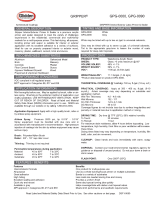
• When using fast-drying coatings, or working in dry, hot or
windy conditions, you’ll need to clean the brushes frequently,
perhaps every two to four hours. Keeping an extra set of
brushes on hand will allow you to remain productive while
the used brushes dry after cleanup.
Protect Your Investment
Any use, storage, or disposal of paint or solvents must
comply with all applicable federal and state laws. C-201114R 4/16
The Wooster Brush Company ∙ 800-392-7246 ∙ woosterbrush.com
• Store brushes hanging inside
their keepers, or wrap the brush
in a paper grocery bag, clean
newsprint, or aluminum foil. If
you can’t hang your brush, at
least lay it flat. Don’t stand a
brush on its end, which will
cause the filaments to curl. Store
roller covers upright in a paper
bag (not plastic) or cardboard box
to avoid flat spots in the fabric.
• After cleaning, dry a brush or
roller by shaking and spinning it
thoroughly. Then take more
moisture out with paper towels
or a clean rag. Never hit a brush
on a pail or the top of your shoe
to get water out. It can
permanently damage the brush.
• If you can’t clean your brush or roller immediately
following a job, wet it with paint and seal it in aluminum foil,
or a plastic bag with the handle sticking out and tied closed
with a twist tie or rubber band. This keeps the brush or
roller from hardening until it can be cleaned properly.
• The 1832 Wooster Painter’s Comb
™
is a valuable tool to
speed up cleaning. Use the comb to separate the filaments,
allowing soap and water into the heel (near the ferrule)
during cleaning, and afterward to straighten the filaments
before storing.
However, if you do want to try to reuse them, work excess
coating out of the brush and clean immediately after use.
Mineral spirits, paint thinners, and lacquer cleaners are
designed for this process. There’s such a wide variety of
oil-based coatings—polyurethanes, stains, enamels,
varnishes, primers—always read the manufacturer’s
recommendations on the can label.
Keep cleaning with the
recommended solvent. Massage
the solvent into the brush bristles.
Change the solvent as it gets
cloudy. And when you think the
brush is clean, do it again. For
synthetic brushes, wash with
solvent and then follow with the
3-step process. Natural bristle
brushes should not be cleaned in
soap and water. Use only the
solvent recommended for thinning the coating to keep the
bristles from flaring. Then spin, comb, and hang to dry.
If you don’t want to invest the
time and effort to clean a roller
cover, let it dry out then throw it
away. This is often the best
choice, especially when using
oil-based coatings or fast-drying
paints, because cleaning is rarely
100% effective. However,
shearling (natural sheepskin) covers are usually worth
preserving if possible. Follow these tips to help improve roller
cleaning for all types of fabrics.
Roller Covers
• Scrape out excess paint with a
5-in-1 tool. Clean immediately
after use.
• Rinse the roller cover thoroughly
with running water.
• Wash with soap and warm water,
then rinse. Choose a detergent that
contains petroleum distillates for
the best results (check the label). Repeat the wash and rinse
steps until the water runs clear.
• Spin until damp. To avoid matting of the fabric, stand on
end to dry.













